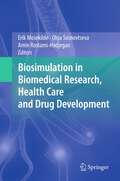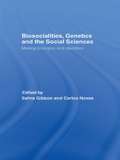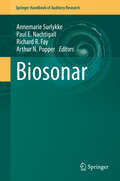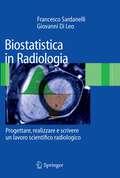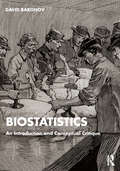- Table View
- List View
Biosimilarity: The FDA Perspective
by Sarfaraz K. NiaziSummary: The focus of this book is on how the U.S. FDA will approve biosimilar drugs, as learned from recent approvals by the FDA. Understanding the limitations of the statutory limits and non-inferiority testing are presented as tools to obviate patient trials and minimize testing of immunogenicity. An in-depth scientific, mathematical and statistical view of the tools required to establish biosimilarity of biological drugs of different complexity -- a must for every developer of biosimilars. Features: First comprehensive analysis based on new guidelines and approval packages of several biosimilars Presents the first approach to challenge FDA in reducing or eliminating any testing in patients. Provides a comprehensive understanding of the U.S. statutory requirements vis-a-vis the regulatory guidelines Provides model CQA and Analytical Similarity testing protocols for cytokines and monoclonal antibodies Allow creation of a fast-to-market pathway to develop biosimilars
Biosimilarity: The FDA Perspective
by Sarfaraz K. NiaziSummary: The focus of this book is on how the U.S. FDA will approve biosimilar drugs, as learned from recent approvals by the FDA. Understanding the limitations of the statutory limits and non-inferiority testing are presented as tools to obviate patient trials and minimize testing of immunogenicity. An in-depth scientific, mathematical and statistical view of the tools required to establish biosimilarity of biological drugs of different complexity -- a must for every developer of biosimilars. Features: First comprehensive analysis based on new guidelines and approval packages of several biosimilars Presents the first approach to challenge FDA in reducing or eliminating any testing in patients. Provides a comprehensive understanding of the U.S. statutory requirements vis-a-vis the regulatory guidelines Provides model CQA and Analytical Similarity testing protocols for cytokines and monoclonal antibodies Allow creation of a fast-to-market pathway to develop biosimilars
Biosimilars: Design and Analysis of Follow-on Biologics
by Shein-Chung ChowAs many biological products face losing their patents in the next decade, the pharmaceutical industry needs an abbreviated regulatory pathway for approval of biosimilar drug products, which are cost-effective, follow-on/subsequent versions of the innovator's biologic products. But scientific challenges remain due to the complexity of both the manuf
Biosimilars: Regulatory, Clinical, And Biopharmaceutical Development (AAPS Advances in the Pharmaceutical Sciences Series #34)
by Hiten J. Gutka Harry Yang Shefali KakarThis book provides a comprehensive overview of the biosimilar regulatory framework, the development process and clinical aspects for development of biosimilars. The development path of a biosimilar is just as unique as a development path of a new drug, tailored by the mechanism of action, the quality of the molecule, published information on the reference product, the current competitive environment, the target market and regulatory guidance, and most importantly, the emerging totality of evidence for the proposed biosimilar during development. For the ease of readers, the book comprises of six sections as follows: Section I: Business, Health Economics and Intellectual Property Landscape for Biosimilars Section II: Regulatory Aspects of Development and Approval for Biosimilars Section III: Biopharmaceutical Development and Manufacturing of Biosimilars Section IV: Analytical Similarity Considerations for Biosimilars Section V: Clinical aspects of Biosimilar Development Section VI: Biosimilars- Global Development and Clinical Experience Chapters have been written by one or more experts from academia, industry or regulatory agencies who have been involved with one or more aspects of biosimilar product development. The authors and editors have an expertise in commercialization and pricing of biosimilars, intellectual property considerations for biosimilars, chemistry manufacturing controls (CMC) and analytical development for biosimilars, regulatory and clinical aspects of biosimilar development. Besides the industry practitioners, the book includes several contributions from regulators across the globe.
Biosimilars: A New Generation of Biologics
by Jean-Louis Prugnaud and Jean-Hugues TrouvinBiologics have revolutionised the treatment of many severe conditions, delivering exceptional clinical results but also producing exceptionally high prices. As patents expire, copies and price competition are expected throughout the world. However, due to the intrinsic heterogeneity and molecular complexity of biologic medicinal products, their copies cannot simply be authorized under the “generic rule” valid for small chemical entities. In response, a dedicated regulation was issued in the European Union. It is based on the concept of “biological medicinal products similar to a biological reference product”, or “biosimilars”. This book analyses the context of biotechnological production and addresses the European legal framework for biosimilar market approval. It highlights post-market authorisation issues, such as Risk Management Plans and substitution of products, and outlines some other issues, such as cost management and international nomenclature. This book is primarily intended for hospital-based physicians and pharmacists. It will also be a valuable resource for all actors from all countries who want to better understand the emergence of these new medicinal products within the European context.
Biosimilars and Interchangeable Biologics: Strategic Elements
by Sarfaraz K. NiaziWhat’s the Deal with Biosimilars? Biosimilars are gaining momentum as new protein therapeutic candidates that can help fill a vital need in the healthcare industry. The biological drugs are produced by recombinant DNA technology that allows for large-scale production and an overall reduction time in costs and development. Part of a two-volume set that covers varying aspects of biosimilars, Biosimilars and Interchangeable Biologics: Strategic Elements explores the strategic planning side of biosimilar drugs and targets issues surrounding biosimilars that are linked to legal matters. This includes principal patents and intellectual property, regulatory pathways, and concerns about affordability on a global scale. It addresses the complexity of biosimilar products, and it discusses the utilization of biosimilars and related biological drugs in expanding world markets. Of specific interest to practitioners, researchers, and scientists in the biopharmaceutical industry, this volume examines the science, technology, finance, legality, ethics, and politics of biosimilar drugs. It considers strategic planning elements that include an overall understanding of the history and the current status of the art and science of biosimilars, and it provides detailed descriptions of the legal, regulatory, and commercial characteristics. The book also presents a global strategy on how to build, take to market, and manage the next generation of biosimilars throughout their life cycle.
Biosimilars and Interchangeable Biologics: Tactical Elements
by Sarfaraz K. NiaziWhat's the Deal with Biosimilars?Biosimilars are gaining momentum as new protein therapeutic candidates that can help fill a vital need in the healthcare industry. The biological drugs are produced by recombinant DNA technology that allows for large-scale production and an overall reduction time in costs and development. Part of a two-volume set th
Biosimilars and Interchangeable Biologics: Strategic Elements
by Sarfaraz K. NiaziWhat’s the Deal with Biosimilars? Biosimilars are gaining momentum as new protein therapeutic candidates that can help fill a vital need in the healthcare industry. The biological drugs are produced by recombinant DNA technology that allows for large-scale production and an overall reduction time in costs and development. Part of a two-volume set that covers varying aspects of biosimilars, Biosimilars and Interchangeable Biologics: Strategic Elements explores the strategic planning side of biosimilar drugs and targets issues surrounding biosimilars that are linked to legal matters. This includes principal patents and intellectual property, regulatory pathways, and concerns about affordability on a global scale. It addresses the complexity of biosimilar products, and it discusses the utilization of biosimilars and related biological drugs in expanding world markets. Of specific interest to practitioners, researchers, and scientists in the biopharmaceutical industry, this volume examines the science, technology, finance, legality, ethics, and politics of biosimilar drugs. It considers strategic planning elements that include an overall understanding of the history and the current status of the art and science of biosimilars, and it provides detailed descriptions of the legal, regulatory, and commercial characteristics. The book also presents a global strategy on how to build, take to market, and manage the next generation of biosimilars throughout their life cycle.
Biosimilars Development Strategies: Fast to Market Approaches
by Sarfaraz K. NiaziAfter 18 years since the first biosimilar was approved, a lot has changed, from the regulatory guidelines to the stakeholder perceptions about the safety and efficacy of biosimilars. However, the development costs remain high, preventing faster entry into markets with more than 200 choices. Analyzing the regulatory filings of all approved biosimilars in the US and EU, a deep analysis of the scientific principles, and continuous challenges to the regulatory authorities have made it possible to plan the development on a fast track. This book teaches how to cut the current time and cost by more than 70%, based on the author's hands-on experience.Features: Describes the emergence of biosimilars since the first publication of the recombinant engineering patent, as well as a listing of all approved recombinant products, their patent expiry and their adoption across the globe. Provides a better understanding of the safety and efficacy of approved biosimilars. Global approval requires accommodating guidelines and detailed planning to avoid redundancy as well as high costs. The basic expectations of the agencies are presented here. Presents a detailed analysis of all EU and FDA-approved products with a comparative analysis. Renowned author and entrepreneur in the field of drug discovery and production.
Biosimilars Development Strategies: Fast to Market Approaches
by Sarfaraz K. NiaziAfter 18 years since the first biosimilar was approved, a lot has changed, from the regulatory guidelines to the stakeholder perceptions about the safety and efficacy of biosimilars. However, the development costs remain high, preventing faster entry into markets with more than 200 choices. Analyzing the regulatory filings of all approved biosimilars in the US and EU, a deep analysis of the scientific principles, and continuous challenges to the regulatory authorities have made it possible to plan the development on a fast track. This book teaches how to cut the current time and cost by more than 70%, based on the author's hands-on experience.Features: Describes the emergence of biosimilars since the first publication of the recombinant engineering patent, as well as a listing of all approved recombinant products, their patent expiry and their adoption across the globe. Provides a better understanding of the safety and efficacy of approved biosimilars. Global approval requires accommodating guidelines and detailed planning to avoid redundancy as well as high costs. The basic expectations of the agencies are presented here. Presents a detailed analysis of all EU and FDA-approved products with a comparative analysis. Renowned author and entrepreneur in the field of drug discovery and production.
Biosimilars for Cancer Treatment: A Promising Approach
by Kamal Dua Shvetank Bhatt Harish Dureja Samir Gunvantbhai Patel Archita Samir PatelThe book delves into the role of biosimilars in the field of cancer treatment. It also discusses the application of biosimilars in various cancer types, from colorectal and cervical to prostate, gastric, lung, pancreatic, breast, hepatocellular, ovarian, and blood cancers. It contains chapters that focus on the clinical trials of biosimilars, providing insights into the latest research and developments. This book serves as a valuable resource for clinicians, researchers, and anyone seeking a comprehensive understanding of the intersection between biosimilars and cancer treatment.
Biosimilars Handbook (PDF)
by Sage PublicationsThis handbook aims to provide updated information on the current progress of biosimilar medicines in the European Union (EU). The first edition of this short guide to biosimilar medicines was published in 2007. At the time of first publication, only 5 biosimilar medicines had been approved in Europe, and both the legislation and concepts for these products were very new. Now the situation has developed and changed, as will be described herein, and the clinical and health economic benefits offered by biosimilar medicines to patients, clinicians and healthcare providers are considerably clearer.
Biosimilars of Monoclonal Antibodies: A Practical Guide to Manufacturing, Preclinical, and Clinical Development
by Cheng Liu K. John MorrowAddressing a significant need by describing the science and process involved to develop biosimilars of monoclonal antibody (mAb) drugs, this book covers all aspects of biosimilar development: preclinical, clinical, regulatory, manufacturing. • Guides readers through the complex landscape involved with developing biosimilar versions of monoclonal antibody (mAb) drugs• Features flow charts, tables, and figures that clearly illustrate processes and makes the book comprehensible and accessible• Includes a review of FDA-approved mAb drugs as a quick reference to facts and useful information• Examines new technologies and strategies for improving biosimilar mAbs
Biosimilars of Monoclonal Antibodies: A Practical Guide to Manufacturing, Preclinical, and Clinical Development
by Cheng Liu K. John MorrowAddressing a significant need by describing the science and process involved to develop biosimilars of monoclonal antibody (mAb) drugs, this book covers all aspects of biosimilar development: preclinical, clinical, regulatory, manufacturing. • Guides readers through the complex landscape involved with developing biosimilar versions of monoclonal antibody (mAb) drugs• Features flow charts, tables, and figures that clearly illustrate processes and makes the book comprehensible and accessible• Includes a review of FDA-approved mAb drugs as a quick reference to facts and useful information• Examines new technologies and strategies for improving biosimilar mAbs
Biosimulation in Biomedical Research, Health Care and Drug Development
by Erik Mosekilde, Olga Sosnovtseva and Amin Rostami-HodjeganBiosimulation is an approach to biomedical research and the treatment of patients in which computer modeling goes hand in hand with experimental and clinical work. Constructed models are used to interpret experimental results and to accumulate information from experiment to experiment.This book explains the concepts used in the modeling of biological phenomena and goes on to present a series of well-documented models of the regulation of various genetic, cellular and physiological processes. The way how the use of computer models allows optimization of cancer treatment for individual patients is discussed and models of interacting nerve cells that can be used to design new treatments for patients with Parkinson's disease are explained. Furthermore this volume provides an overview on the use of models in industry, and presents the view of regulatory agencies on the topic.
Biosimulation in Drug Development
by Martin Bertau Erik Mosekilde Hans V. WesterhoffThis first comprehensive survey to cover all pharmaceutically relevant topics provides a comprehensive introduction to this novel and revolutionary tool, presenting both concepts and application examples of biosimulated cells, organs and organisms. Following an introduction to the role of biosimulation in drug development, the authors go on to discuss the simulation of cells and tissues, as well as simulating drug action and effect. A further section is devoted to simulating networks and populations, and the whole is rounded off by a look at the potential for biosimulation in industrial drug development and for regulatory decisions. Part of the authors are members of the BioSim Network of Excellence that encompasses more than 40 academic institutions, pharmaceutical companies and regulatory authorities dealing with drug development; other contributors come from industry, resulting in a cross-disciplinary expert reference.
Biosocial Foundations of Family Processes (National Symposium on Family Issues)
by Alan Booth, Susan M. McHale and Nancy S. LandaleBiosocial Research Contributions to Family Processes and Problems, based on the 17th annual National Symposium on Family Issues, examines biosocial models and processes in the context of the family. Research on both biological and social/environmental influences on behavior, health, and development is represented, including behavioral endocrinology, behavior genetics, neuroscience, evolutionary psychology, sociology, demography, anthropology, economics, and psychology. The authors consider physiological and social environmental influences on parenting and early childhood development, followed by adolescent adjustment, and family formation. Also, factors that influence how families adapt to social inequalities are examined.
Biosocialities, Genetics and the Social Sciences: Making Biologies and Identities
by Sahra Gibbon Carlos NovasBiosocialities, Genetics and the Social Sciences explores the social, cultural and economic transformations that result from innovations in genomic knowledge and technology. This pioneering collection uses Paul Rabinow’s concept of biosociality to chart the shifts in social relations and ideas about nature, biology and identity brought about by developments in biomedicine. Based on new empirical research, it contains chapters on genomic research into embryonic stem cell therapy, breast cancer, autism, Parkinson’s and IVF treatment, as well as on the expectations and education surrounding genomic research. It covers four main themes: novel modes of identity and identification, such as genetic citizenship the role of institutions, ranging from disease advocacy organizations and voluntary organizations to the state the production of biological knowledge, novel life-forms, and technologies the generation of wealth and commercial interests in biology. Including an afterword by Paul Rabinow and case studies on the UK, US, Canada, Germany, India and Israel, this book is key reading for students and researchers of the new genetics and the social sciences – particularly medical sociologists, medical anthropologists and those involved with science and technology studies.
Biosocialities, Genetics and the Social Sciences: Making Biologies and Identities
by Sahra Gibbon Carlos NovasBiosocialities, Genetics and the Social Sciences explores the social, cultural and economic transformations that result from innovations in genomic knowledge and technology. This pioneering collection uses Paul Rabinow’s concept of biosociality to chart the shifts in social relations and ideas about nature, biology and identity brought about by developments in biomedicine. Based on new empirical research, it contains chapters on genomic research into embryonic stem cell therapy, breast cancer, autism, Parkinson’s and IVF treatment, as well as on the expectations and education surrounding genomic research. It covers four main themes: novel modes of identity and identification, such as genetic citizenship the role of institutions, ranging from disease advocacy organizations and voluntary organizations to the state the production of biological knowledge, novel life-forms, and technologies the generation of wealth and commercial interests in biology. Including an afterword by Paul Rabinow and case studies on the UK, US, Canada, Germany, India and Israel, this book is key reading for students and researchers of the new genetics and the social sciences – particularly medical sociologists, medical anthropologists and those involved with science and technology studies.
Biosonar (Springer Handbook of Auditory Research #51)
by Annemarie Surlykke Paul E. Nachtigall Richard R. Fay Arthur N. PopperTwo groups of animals, bats and odontocetes (toothed whales), have independently developed the ability to orient and detect prey by biosonar (echolocation). This active mechanism of orientation allows these animals to operate under low light conditions. Biosonar is a conceptual overview of what is known about biosonar in bats and odontocetes. Chapters are written by bat and odontocetes experts, resulting in collaborations that not only examine data on both animals, but also compare and contrast mechanisms. This book provides a unique insight that will help improve our understanding of biosonar in both animal groups.
Biostatistica in Radiologia: Progettare, realizzare e scrivere un lavoro scientifico radiologico
by Francesco Sardanelli Giovanni Di LeoLo scopo di questo libro consiste nel presentare ai radiologi problemi e metodi statistici in modo agile, ponendo l'accento su argomenti statistici frequentemente impiegati in studi radiologici (es. test non-parametrici, paragone di sensibilità e specificità nelle diverse modalità di imaging, differenze fra applicazioni cliniche e di screening di test radiologici, ecc). I test saranno presentati partendo da un problema radiologico e tutti gli esempi statistici di metodi e applicazioni saranno tratti dal mondo radiologico.
Biostatistical Applications in Cancer Research (Cancer Treatment and Research #113)
by Craig BeamBiostatistics is defined as much by its application as it is by theory. This book provides an introduction to biostatistical applications in modern cancer research that is both accessible and valuable to the cancer biostatistician or to the cancer researcher, learning biostatistics. The topical areas include active areas of the application of biostatistics to modern cancer research: survival analysis, screening, diagnostics, spatial analysis and the analysis of microarray data.Biostatistics is an essential component of basic and clinical cancer research. The text, authored by distinguished figures in the field, addresses clinical issues in statistical analysis. The spectrum of topics discussed ranges from fundamental methodology to clinical and translational applications.
Biostatistical Methods in Epidemiology (Wiley Series in Probability and Statistics #Vol. 484)
by Stephen C. NewmanAn introduction to classical biostatistical methods in epidemiology Biostatistical Methods in Epidemiology provides an introduction to a wide range of methods used to analyze epidemiologic data, with a focus on nonregression techniques. The text includes an extensive discussion of measurement issues in epidemiology, especially confounding. Maximum likelihood, Mantel-Haenszel, and weighted least squares methods are presented for the analysis of closed cohort and case-control data. Kaplan-Meier and Poisson methods are described for the analysis of censored survival data. A justification for using odds ratio methods in case-control studies is provided. Standardization of rates is discussed and the construction of ordinary, multiple decrement and cause-deleted life tables is outlined. Sample size formulas are given for a range of epidemiologic study designs. The text ends with a brief overview of logistic and Cox regression. Other highlights include: Many worked examples based on actual data Discussion of exact methods Recommendations for preferred methods Extensive appendices and references Biostatistical Methods in Epidemiology provides an excellent introduction to the subject for students, while also serving as a comprehensive reference for epidemiologists and other health professionals. For more information, visit www.wiley.com/mathematics
Biostatistics: An Introduction and Conceptual Critique
by David BaronovWithout question, biostatistical analysis has contributed to a slew of amazing medical breakthroughs. Yet it also distorts and deforms the holistic and contingent nature of health and medicine. How is it that biostatistics can both sharpen and weaken our understanding of health and medicine? What is unique about the content of health and medicine that so plainly reveals such distortions and deformities? Exploring these questions entails, first, a full survey of the tools and techniques of biostatistical analysis aiding medical breakthroughs. This survey must then be paired with a probe into the conceptual premises of these tools and techniques and how they refashion and reconstitute the inherently qualitative content of health and medicine in preparation for its quantification. We must grasp the statistical machinations at play, both technical and conceptual, that contrive to fit objects to tools rather than fitting tools to objects. This textbook introduces both the procedural methods and the hidden premises of biostatistical analysis.
Biostatistics: An Introduction and Conceptual Critique
by David BaronovWithout question, biostatistical analysis has contributed to a slew of amazing medical breakthroughs. Yet it also distorts and deforms the holistic and contingent nature of health and medicine. How is it that biostatistics can both sharpen and weaken our understanding of health and medicine? What is unique about the content of health and medicine that so plainly reveals such distortions and deformities? Exploring these questions entails, first, a full survey of the tools and techniques of biostatistical analysis aiding medical breakthroughs. This survey must then be paired with a probe into the conceptual premises of these tools and techniques and how they refashion and reconstitute the inherently qualitative content of health and medicine in preparation for its quantification. We must grasp the statistical machinations at play, both technical and conceptual, that contrive to fit objects to tools rather than fitting tools to objects. This textbook introduces both the procedural methods and the hidden premises of biostatistical analysis.










